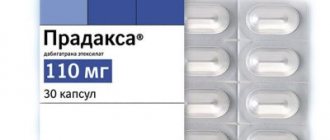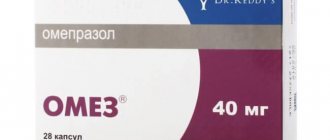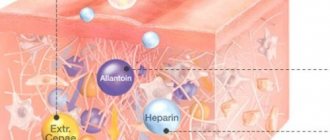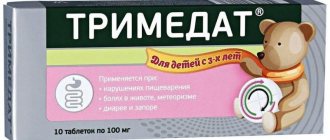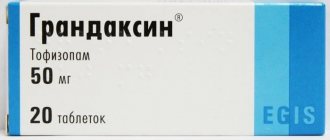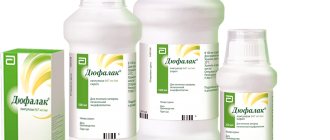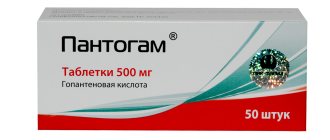Hypersensitivity, “aspirin” asthma, peptic ulcer of the stomach and duodenum (in the acute stage), liver and/or renal failure (creatinine clearance less than 30 ml/min), nephrourolithiasis (including a history), during excretion with urine more than 800 mg of urates/day, concomitant therapy with cytostatics, radiation therapy of the tumor, blood disorders, pregnancy, lactation, childhood. With caution. History of blood disorders and peptic ulcer of the stomach and duodenum, chronic renal failure (CC Side effects:
Allergic reactions (skin rash, dermatitis, hyperthermia), dyspepsia, nausea, vomiting, abdominal pain, diarrhea;
gastrointestinal bleeding, agranulocytosis, leukopenia, thrombocytopenia, aplastic anemia, pancytopenia, exacerbation of gout (massive excretion of uric acid or lituresis at the beginning of treatment), impaired renal function. Overdose. Symptoms: nausea, vomiting, epigastric pain, diarrhea, ataxia, convulsions, shortness of breath, acute renal failure, coma. Treatment: gastric lavage, symptomatic therapy, intravenous dextrose. There is no specific antidote. If necessary, hemodialysis. Interaction:
Strengthens the effect of anticoagulants, antiplatelet agents, fibrinolytics, hypoglycemic and antigout drugs;
increases T1/2 of oral hypoglycemic drugs, penicillin and sulfonamides. Ethanol, ethacrynic acid, thiazide diuretics reduce effectiveness. Salicylates exhibit antagonism to the uricosuric effect and increase the risk of bleeding; Saluretics increase plasma urate concentrations. Combination with allopurinol leads to an additive effect. Special instructions:
Treatment with sulfinpyrazone in patients with gouty arthritis begins 2-3 weeks after an acute attack of gout.
If an attack occurs while using the drug, treatment should be continued simultaneously with colchicine or NSAIDs. The drug increases the incidence of an acute attack of gout at the beginning of treatment; therefore, the listed drugs should be prescribed simultaneously during the first 3-6 months of treatment (however, this also does not prevent the occurrence of an acute attack of gout). The patient should receive a sufficient amount of fluid (at least 2-3 l/day); urine should be alkalinized (sodium bicarbonate 3-7.5 g/day or potassium citrate 7.5 g/day) since increased excretion of uric acid during acidic urine may contribute to the formation of stones (in the first few months of treatment) in the urinary tract. During the treatment period, it is recommended to determine the level of uric acid in the blood serum and urine for 24 hours in order to adjust the dose of the drug; in patients with chronic renal failure, renal function. Should be taken with food or antacid medications to reduce gastrointestinal side effects. When prescribed to patients who have recently suffered a myocardial infarction, it is recommended to regularly perform a general urine test and determination of creatinine and urea, especially at the beginning of therapy. During the treatment period, it is necessary to monitor the prothrombin index. When diagnosing urates, diuretics should be stopped 2-3 days before the start of the study. When simultaneously prescribing ASA or other drugs that can affect hemostasis, the patient should be advised of the need to immediately consult a doctor in case of any unusual bleeding. For children, the dosage regimen is not defined. Preparations containing the active substance Sulfinpyrazone:
Anturan, Apo-Sulfinpyrazone
The information provided in this section is intended for medical and pharmaceutical professionals and should not be used for self-medication. The information is provided for informational purposes only and cannot be considered official.
Fluxum®
Fluxum® cannot be administered intramuscularly.
Parnanapine-induced thrombocytopenia
It is known that Fluxum®, like heparin itself and other low molecular weight heparins, can cause thrombocytopenia. Heparin-induced thrombocytopenia usually develops 4-10 days after the start of treatment or earlier in case of repeated cases. In 10-20% of patients, early mild thrombocytopenia (platelets >100,000/μl) occurs, which may persist or regress with continued treatment. As a result of the formation of antibodies to the heparin/platelet factor 4 complex, in some cases a more severe immune form, heparin-induced thrombocytopenia type II, may develop, followed by thrombus formation and thromboembolism in the arteries of the brain, lungs, lower extremities, etc., often with a fatal outcome. These patients may develop a new thrombus associated with thrombocytopenia caused by irreversible heparin-induced platelet aggregation, so-called white clot syndrome.
During treatment with Fluxum®, patients should be carefully monitored. Therefore, in the event of thrombocytopenia or in the event of symptoms associated with a new thrombotic event, or in the event of worsening of a previous thrombotic event, low molecular weight heparin should be discontinued. Alternative anticoagulant therapy should be attempted after discontinuation of heparin. Immediate use of oral anticoagulant therapy should be avoided as exacerbation of thrombosis has been observed.
During long-term treatment, the platelet count should be determined before starting therapy with Fluxum® and 2 times a week for the first month, and then monitoring of the platelet count may be less frequent. Fluxum should be prescribed with extreme caution to patients with a history of thrombocytopenia caused by heparin or other low molecular weight heparin; their platelet count should be performed every day. If thrombocytopenia occurs during heparin treatment, low molecular weight heparin therapy may be an alternative treatment option. In this case, the platelet count should be determined daily and, if thrombocytopenia persists, then low molecular weight heparin should be discontinued as early as possible. If thrombocytopenia is less than 100,000/μl, if thrombosis occurs and progresses, Fluxum® must be discontinued and the patient transferred to another anticoagulant therapy. Switching to oral anticoagulant therapy in these cases is not recommended, since thrombosis progression is known.
If heparin-induced thrombocytopenia is suspected, in vitro platelet aggregation tests do not have much diagnostic value; specialist consultation is necessary.
Spinal/epidural anesthesia
Carrying out spinal or epidural anesthesia, spinal-epidural analgesia or lumbar puncture during the prophylactic use of Fluxum®, as well as other low-molecular-weight heparins, may be complicated by spinal or epidural hematoma with the development of persistent or irreversible paralysis. The risk of these complications increases with the use of epidural catheters, the use of concomitant NSAIDs, antiplatelet drugs or anticoagulants, trauma or repeated spinal punctures, the presence of underlying hemostatic disorders, or in elderly patients. If it is necessary to carry out anesthesia/analgesia of this type during the prophylactic use of the drug Fluxum®, the presence of these risk factors should be carefully checked before these interventions. Typically, spinal catheters are installed no earlier than 8-12 hours after the last administration of a prophylactic dose of low molecular weight heparin. Fluxum® should not be administered 2-4 hours before and after insertion/removal of a catheter. The injection should be delayed or canceled if blood is aspirated from the spinal canal during spinal or epidural anesthesia. The catheter should be removed as soon as possible after (8-12 hours) the last prophylactic administration of Fluxum®.
Particular attention should be paid to patients who received Fluxum® before or after epidural or spinal anesthesia, checking for the presence of neurological symptoms such as low back pain, sensory and motor disorders (numbness or weakness in the lower extremities), bowel or bladder dysfunction. Patients should be informed of the need to immediately consult a doctor if these symptoms appear. If an epidural or spinal hematoma is suspected, prompt diagnosis and treatment, including spinal cord decompression, is required.
Non-interchangeability of sodium parnaparin with other low molecular weight heparins and unfractionated heparin.
Parnaparin cannot be interchanged (unit for unit) with unfractionated heparin, with other low molecular weight heparins or with synthetic polysaccharides. Each of these drugs differs in their starting materials, manufacturing process, physicochemical, biological and clinical properties, resulting in differences in biochemical identity, dosage and possibly clinical efficacy and safety. Each of these medications is unique and has its own instructions for use. If skin necrosis occurs, treatment with Fluxum® must be interrupted.
Switching from Fluxum® to oral anticoagulants
— Switching from Fluxum® to vitamin K antagonists (VKA).
Since there is an interval before VKA reaches its maximum effect, treatment with Fluxum® should not be interrupted until the required INR (International Normalized Ratio) is achieved.
— Switching to direct oral anticoagulants (DOAs):
These drugs should not be prescribed simultaneously with Fluxum®.
Treatment with DOACs should be initiated at the end of the recommended parnaparin treatment period and at the exact time that subsequent parnaparin administration would have been scheduled if parnaparin treatment had been continued.
There is no experience with the use of Fluxum® in patients with mechanical prosthetic valves (including pregnant women).
Heparins may suppress adrenal aldosterone secretion, leading to hyperkalemia, especially in patients with diabetes mellitus, chronic renal failure, pre-existing metabolic acidosis, elevated plasma potassium levels, or taking potassium-sparing medications. The risk of hyperkalemia appears to increase with duration of therapy but is usually reversible. Plasma potassium levels should be measured in patients at risk before initiating heparin therapy and then monitored regularly, especially if treatment is extended beyond 7 days.
Children: the use of Fluxum® in patients under 18 years of age is included in the “Contraindications” because efficacy and safety have not been established. Elderly patients: Elderly patients (especially those over eighty years of age) may be at greater risk of bleeding complications, so close clinical monitoring is recommended. However, there is no need to reduce the recommended doses of Fluxum® unless renal function is seriously impaired.
Renal Impairment: As stated in the Precautions section of the Contraindications section, the use of Fluxum® in patients with renal impairment should be used with caution and is associated with increased drug exposure, which increases the risk of bleeding: therefore, careful clinical monitoring is recommended. In cases of severe renal impairment (creatine clearance <30 ml/min), an increased risk of bleeding may also be observed at recommended doses, so a reduction in the Fluxum® dose may be required in these patients and monitoring of plasma anti-Xa activity is recommended.
Hepatic impairment: As advised in the Precautions section of the Contraindications section, the use of Fluxum® should also be used with caution in patients with impaired liver function, again due to the increased risk of bleeding: careful clinical monitoring is also recommended. .
Description of the drug APIXA
With the simultaneous use of apixaban and ketoconazole (at a dose of 400 mg, 1 time / day), which is a powerful inhibitor of both the CYP3A4 isoenzyme and P-glycoprotein, an increase in the average AUC value of apixaban by 2 times and the average Cmax by 1.6 times was observed. No dose adjustment of apixaban is required with this combination; however, apixaban should be used with caution in patients receiving systemic therapy with azole antifungals, in particular ketoconazole, or other potent inhibitors of the CYP3A4 isoenzyme and P-glycoprotein.
Drugs that moderately reduce the rate of elimination of apixaban or inhibit the CYP3A4 isoenzyme and/or P-glycoprotein may lead to an increase in plasma concentrations of apixaban to a lesser extent. For example, diltiazem (a moderate inhibitor of the CYP3A4 isoenzyme and a weak inhibitor of P-glycoprotein) at a dose of 360 mg 1 time / day led to an increase in the average AUC values of apixaban by 1.4 times and the average Cmax values by 1.3 times. Naproxen (a P-glycoprotein inhibitor) when administered at a dose of 500 mg to healthy volunteers caused an increase in the mean AUC and Cmax of apixaban by 1.5 and 1.6 times, respectively. At the same time, there was an increase in the values of blood coagulation parameters.
The combination of apixaban with rifampicin (a potent inducer of CYP3A4 and P-glycoprotein) resulted in a decrease in the mean AUC and Cmax of apixaban by approximately 54% and 42%, respectively. Apparently, the combination of apixaban with other potent inducers of the CYP3A4 isoenzyme and P-glycoprotein (in particular, phenytoin, carbamazepine, phenobarbital or St. John's wort preparations) may also lead to a decrease in the concentration of apixaban in the blood plasma. No dose adjustment of apixaban is required when combined with drugs in this group, but these drugs should be combined with caution.
After co-administration of enoxaparin (single dose, 40 mg) and apixaban (single dose, 5 mg), an additive effect of these drugs on the activity of coagulation factor Xa was noted.
The combination of apixaban with clopidogrel (at a dose of 75 mg, 1 time / day) or a combination of clopidogrel (75 mg) and acetylsalicylic acid (162 mg, 1 time / day), according to some data, did not lead to an increase in bleeding time or further inhibition of platelet aggregation or an increase in blood coagulation system parameters (prothrombin time, MHO and APTT) compared with the use of these antiplatelet agents in monotherapy. However, caution should be exercised when using apixaban simultaneously with NSAIDs (including acetylsalicylic acid), due to the fact that these drugs increase the risk of bleeding.
Do not simultaneously use drugs whose effects may be associated with the development of serious bleeding, such as thrombolytics, glycoprotein IIb/IIa receptor antagonists, thienopyridines (for example, clopidogrel), dipyridamole, dextran, sulfinpyrazone.
Combining apixaban (at a dose of 10 mg) with atenolol (at a dose of 100 mg) did not lead to the development of clinically significant changes in the pharmacokinetic parameters of apixaban, but it was accompanied by a decrease in the average AUC and Cmax values of apixaban by 15% and 18%, respectively, compared with the monotherapy regimen .
In in vitro studies, apixaban caused a slight suppression of the activity of the CYP2C19 isoenzyme (IC50 > 20 μmol/L) by apixaban at a concentration significantly higher than the Cmax in plasma when used clinically.
Taking activated charcoal reduces the effects of apixaban.
